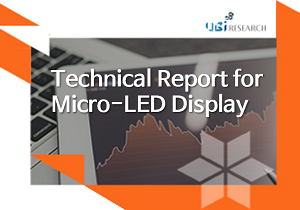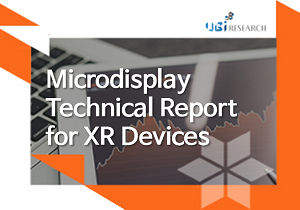Special Report
2022 Micro-display Technology Report
₩5,000,000
March 22, 2022
PDF(116p)Introduction
As the mobile phone of the past had evolved into the smartphone we know today, the smart era that had begun is teeming to evolve once again. This time it is in the form of wearables as in Augmented Reality Glasses otherwise known as, AR Glasses.
A smartphone is classified as a mobile device because it can be carried around and carried in a bag or pocket. However, AR Glasses are classified as wearable devices because it is a device worn on the face.
AR Glasses have transparent glass on the front just like any ordinary glasses and the information to be displayed is also imaged on this glass. This gives the user the advantage to see information immediately while walking. In addition, various information can be displayed on top of visible objects through the transparent glass, making it a new experience different from previous information devices.
As micro-displays, which make up AR Glasses, there are LCoS (liquid crystal on silicon), OLEDoS (OLED on silicon), micro-LED, MEMS, etc., in which liquid crystal or OLED is placed on a silicon substrate.
In addition to AR Glasses, VR devices are establishing themselves as essential devices in the Metaverse Era. VR devices will provide a more immersive experience for games and movies than any other preceding devices. For VR displays, micro-displays are mainly used.
Accordingly, the world’s best IT companies such as Apple, Meta, Google, and Sony are spurring on the development and commercialization of AR Glasses and VR devices.
AR Glasses and micro-displays for VR devices will establish themselves as game-changers. These devices are set to replace smartphones and game consoles, and other information devices within the coming years.
In this micro-display report, the product trends of AR Glasses, VR device developers, and the current development status of micro-display (a key component of AR and VR) were thoroughly investigated to analyze technological progress and problems in detail.
Contents
1.1 Overview
1.2 AR
1.3 VR
1.4 XR
1.5 XR equipment
1.6 Micro display
2. AR Development Trends
2.1 Evolution of Information Devices and Displays
2.2 Near-Eye Display Products
2.3 Optical System of Near-Eye Display
– 2.3.1 Projection Type ( look around )
– 2.3.2 Beam Splitter Type Display
– 2.3.3 Waveguide Type Optical system
– 2.3.4 Micro mirror system
– 2.3.5 Retinal scanning display
2.4 Micro-display used in AR Glass
– 2.4.1 Non-Emissive Micro-Display
– 2.4.2 Emissive Micro-Display
2.5 Combination of Display Device and Optics in AR Devices
3. VR Development Trends
3.1 What is required of VR equipment
– 3.1.1 wide FOV
– 3.1.2 High resolution
– 3.1.3 Fast response
3.2 Commercialized VR equipment
– 3.2.1 PlayStation VR
– 3.2.2 Oculus
– 3.2.3 HTC
– 3.2.4 Other VR products with wide FOV and high resolution
– 3.2.5 Display resolution of VR products
3.3 Newly developed VR equipment
– 3.3.1 Panasonic
– 3.3.2 Sony
– 3.3.3 Resolution of newly developed VR equipment
3.4 Support for 3D display
– 3.4.1 Problems with conventional 3D display methods
– 3.4.2 Light field display
4. Micro-OLED
4.1 Status of Micro-OLED Business
– 4.1.1 Micro OLED Structure and Application Areas
– 4.1.2 eMagin
– 4.1.3 Sony
– 4.1.4 MICROOLED
– 4.1.5 Kopin
– 4.1.6 BOE
– 4.1.7 EPSON
– 4.1.8 Specifications of each company’s product lineup
– 4.1.9 Micro OLED product size and pixel pitch of each company
4.2 White + CF type Micro-OLED with high resolution
– 4.2.1 Color Filter array
– 4.2.2 Meta Surface
4.3 White + CF type Micro-OLED with high brightness
– 4.3.1 RGBW Color Filter
– 4.3.2 Tandem
– 4.3.3 Low voltage Tandem
– 4.3.4 Micro Lens array
– 4.3.5 Light distribution control
4.4 RGB Direct Patterning of Micro-OLED
– 4.4.1 Lithography
– 4.4.2 Flash Mask Transfer Lithography ( FMTL )
– 4.4.3 Ultra High Definition Mask
4.5 AR Glass using Micro-OLED
– 4.5.1 EPSON
– 4.5.2 Nreal
– 4.5.3 ETRI
5. Monolithic Micro LED
5.1 Hybridization of Monolithic Micro LED and Driver chip
– 5.1.1 CEA-LETI
– 5.1.2 Sharp
– 5.1.3 GaN on Si wafer
5.2 Mass Production Improvement of Monolithic Micro LED
– 5.2.1 CEA-LETI
– 5.2.2 Jade Bird Display
5.3 Monolithic TFT on GaN Micro LED
5.4 Relationship between size and luminous efficiency of Micro LED
5.5 Nanowire ( Nanocolumn )
5.6 Complete Monolithic Micro LED
5.7 Full Color of Monolithic Micro LED
– 5.7.1 Color conversion by QD
– 5.7.2 Direct color by nanocolumn
– 5.7.3 Quantum Photonic Imager ( QPI )
– 5.7.4 Full color with Monolithic GaN
5.8 Commercialization of Monolithic Micro LED
– 5.8.1 Plessey Semiconductor
– 5.8.2 Jade Bird Display ( JBD )
5.9 AR Glass with Micro LED
– 5.9.1 VUZIX
– 5.9.2 TCL
– 5.9.3 Oppo
6. Micro OLED or Micro LED ?
6.1 View from the Micro OLED side
6.2 Brightness comparison : Micro LED vs Micro OLED
– 6.2.1 Brightness of Micro-LED
– 6.2.2 Brightness of Micro-OLED
6.3 Full Color : Micro LED vs Micro OLED
6.4 Drive Systems and more : Micro LED vs Micro OLED
Report Sample
Previous Report Status
Related Products
-

Technical Report for Micro-LED Display
₩0June 11, 2024
PDF(124p)Micro-LED displays, which are attracting attention as one of the next-generation display technologies, use micrometer-sized LEDs, which are self-light-emitting elements, and have advantages such as high resolution, high brightness, high efficiency, and long lifespan.It is mainly being applied on a pilot basis to small-sized AR/VR devices and large-sized TV fields, but is expanding to various areas such as automotive, transparent, and microdisplay.
Korea, China, Taiwan, and the United States are leading the way in Micro-LED development. Among them, China provides national support and many Chinese companies are aggressively developing, and Taiwan is aiming to create a new market in the field of commercial displays using Micro-LED.
[Micro-LED Technology and Development Trends Report] published by UBI Research not only provides a detailed analysis of Micro-LED technology, but also includes the technology status and company status by application field, as well as Micro-LED application products and Micro-LED chip market forecasts. It’s a report. It will provide strategic direction as an important reference for companies working in the Micro-LED field. -

Micro Display Technology Report
₩5,000,000December 15, 2021
Glasses-type wearable devices are attracting attention as cutting-edge IT products that will succeed smartphones and smart watches. Wearable devices are being used in various industries, from AR and VR to XR and MR. Google, Facebook, and Sony are already releasing AR Glass with various performances, and are spurring software development along with hardware development. The most important part of the glasses-type wearable device is the micro display. In particular, AR, XR, and MR devices are required to display high definition, high brightness, and light weight because virtual reality or augmented reality must be displayed in accordance with reality. This report analyzed the latest development trends of micro display and included them by technology. It is structured so that companies that are promoting the next-generation wearable device business and software business can know the direction of the micro display industry.
-

Microdisplay Technical Report for XR Devices
₩5,000,000October 31, 2023
PDF(154p)The “Microdisplay Technology Report for XR Devices” will be a useful guideline for companies and researchers working in the display industry to easily identify research trends and development directions by closely analyzing XR industry trends and technologies and challenges needed to manufacture microdisplays for high-performance XR devices.


